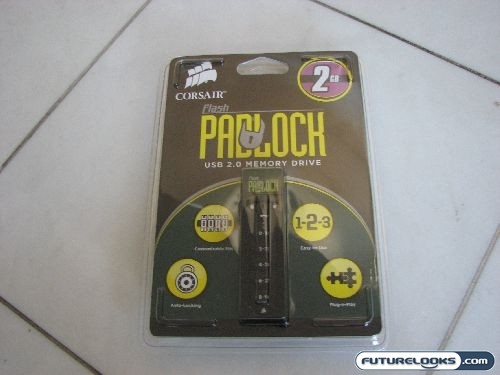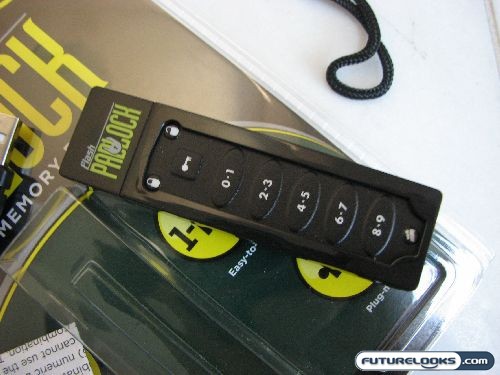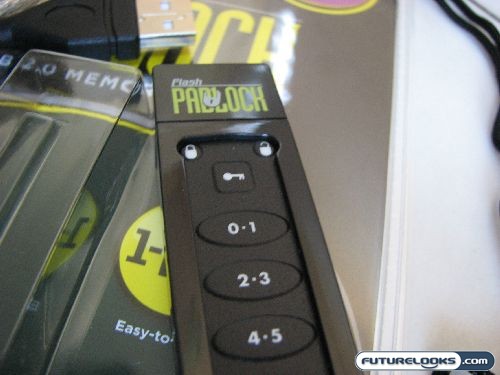Security is a very big deal. If you’re just transferring some music files and family pictures, it might not be all that important, but if you’re transporting financial documents and other personal information, it’s important to protect that data however you can. Manufacturers of USB Flash drives have come up with many different ways to encrypt and otherwise lock your data in such a way that random passers by won’t be able to access those all important 1s and 0s.

The Corsair Padlock USB 2.0 memory drive is one such device. While other products may boast some sort of software protection, the Corsair Padlock comes equipped with a simple numerical keypad right on the flash drive itself. Working much your PIN at an ATM, a certain number must be entered before the drive is unlocked and ready to use. In fact, if you plug a locked Corsair Padlock into an available USB port on your computer, it won’t even recognize it. It won’t think that there’s anything there until you unlock the device by entering a code. Extra secure, right?
From One to Ten Digits
The unlocking code on the Corsair Padlock USB Flash drive can be customized, ensuring that you have a truly personal identification number. In addition to the “key” button, there are five other buttons corresponding to the numbers 0 through 9.

“What? Five buttons? I thought you said it had 10 digits?”
I did. Much like some the keyless entry systems on cars, there are two numbers mapped to each button. In this way, you don’t really have all ten digits available to you; they’re just there as memory aids, because there are only five different possibilities. Thankfully, the length of your PIN is also customizable.

According to the provided documentation, the unlocking code can be anywhere from one to ten digits in length. For example, your PIN can be 2 or it can be 1234567890… or anything in between. Most people will probably select codes that are four or five numbers long, but you can really throw off would-be data thieves by picking an obscure 7-digit code, for example. At its maximum length (ten digits), you essentially have 9,765,625 unique codes (5^10).
If you look at all the possibilities with all the possible lengths, you end up with 12,207,030 unique unlocking codes: this is calculated by 5^1 + 5^2 + 5^3 + 5^4 + 5^5 + 5^6 + 5^7 + 5^8 + 5^9 + 5^10. Yeah, go ahead and try to guess using brute force.
Real-Time Price and Stock Check – Shop Like a Pro!
Fit and Finish
If you’re looking for a nice compact USB flash drive, the Corsair Padlock most certainly does not fit the bill. Compared to something like the OCZ Rally2 or the Sandisk Micro Cruzer, the Corsair Padlock is a relative Goliath. The lack of rounded corners or softened edges adds to its formidable stature.
The drive, with the cap, measures 8.5×2.3×1.4cm (3.5×0.9×0.5 inches). It’s pretty beefy in stature, but given that it has to have that rather large numerical keypad, the size is understandable.
I’m not as impressed with the choice of materials. While the slightly textured soft keypad feels fine, the rest of housing is composed of some rather cheap-feeling plastic. The Corsair Padlock features a glossy black finish and because it is so smooth, you feel like you’re holding a toy and not a tough business-protecting device. It’s solid and the seals are great, but that still doesn’t dispel the impression of cheapness.
Performance
Based on the benchmark provided by HD Tune, the Corsair Padlock USB Flash drive is a solid performer. The data transfer rate fluctuated between 18.9MB/sec and 20.0MB/sec, coming out with an average of 19.5MB/sec. The burst rate was slightly less impressive at 14.7MB/sec, but the access time is quite good at 0.7ms. All in all, the average consumer will be quite happy with how this drive does in terms of moving data around. If you really want something faster, but can do without security, Corsair’s Voyager GT might be better suited for you.
In a real world test, the numbers differ quite a bit more. The write speed appears to be substantially slower than the read speed, because there is a substantial difference between the time it took to dump a file onto the drive and the time it took to take a file from the drive. Sending a 700MB video file to the Corsair Padlock took 1 minute and 38 seconds. This works out to an approximate data transfer rate of 7.14MB/sec, a far cry from the rate evidenced by HD Tune.
By contrast, when a file was taken from the Padlock and written onto the computer’s hard drive, the same 700MB file took a mere 37 seconds. That works out to a rate of 18.92MB/sec, right in line with the HD Tune benchmark. As you can see, reading and writing is very different on this drive. To compete with the big boys, Corsair is going to need to up the ante in terms of write speed.
The performance of the locking mechanism was intuitive and effective. To initially set the code, you hold the key button until both the red and green lights illuminate. You enter your code of between one and ten digits, pressing the key button again to end the sequence. It will ask you to confirm the code once more, pressing the key button one last time. To unlock the drive, simply press the key button and then enter your code. It couldn’t be easier.
Real-Time Price and Stock Check – Shop Like a Pro!
Conclusion
The concept behind the 2GB Corsair Padlock USB 2.0 Memory Drive is a decent one. I appreciate the fact that the drive has an auto-locking mechanism, so you don’t have to worry about locking the drive each time you finish using it. For people who have a tendency to forget things, Corsair offers a service wherein you can store your PIN online for later retrieval. This is handy, but obviously a security risk. Without it, you may be lost to your data forever though.
The data transfer performance was decent, but the write speed was quite poor. Read speeds are up to snuff. This is an unfortunate shortcoming that Corsair could have easily addressed. I’m also not a big fan, no pun intended, of the relatively large form factor. A more compact solution would have been appreciated, but the keys are already pretty small. Perhaps a virtual keypad that appears upon USB connection would work.
In the end, the extra size and the poor write speed are not enough to compensate for the security offered by the PIN mechanism. The Corsair Padlock is okay, but far from great.
Pros
- Easy to use, secure
- Auto-locking mechanism is handy
- Free USB extension cable a bonus
Cons
- Relatively large form factor
- Cheap feel to casing, overall appearance
- Write speed is poor
- May be difficult to insert next to other USB peripherals
Overall Rating: 6.0 /10.0
Discuss This Review in the Futurelooks Community Forums
Real-Time Price and Stock Check – Shop Like a Pro!
